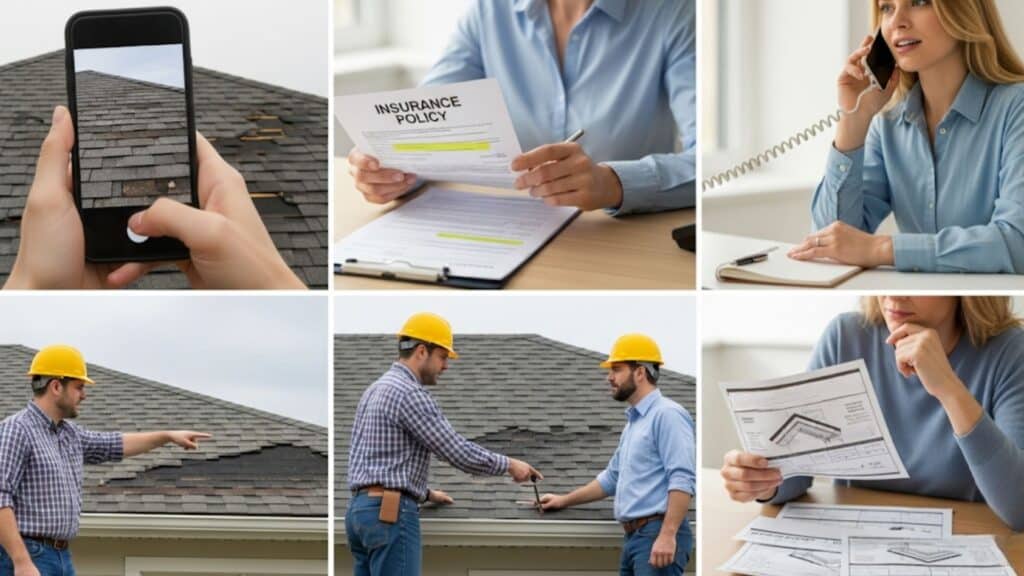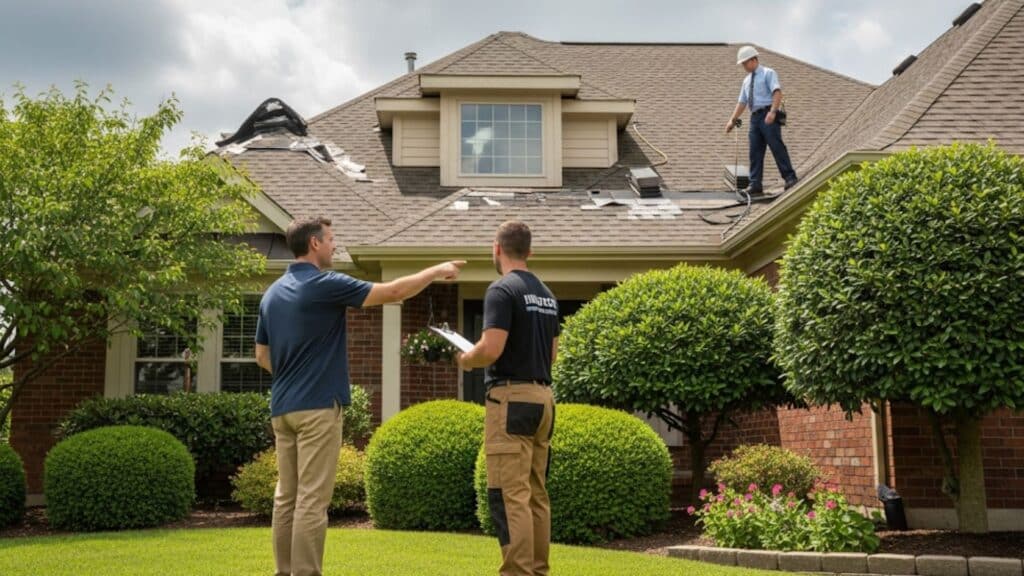Ever stared at roof damage and thought If your insurance would actually pay for a new one? Learning how to get insurance to pay for roof replacement can save you thousands of dollars.
Most homeowners are unaware of the proper steps to take when filing claims. You need to understand what insurance companies look for before approving payments.
I’ve seen too many people get denied because they missed key details during the process. This involves smart planning and knowing exactly what to do at each step.
Insurance companies have specific rules you must follow to get approved. Success requires patience and the right strategy. Time to take charge and get what you paid for.
Does Homeowners Insurance Cover Roof Replacement?
Most homeowners’ insurance policies in the USA cover roof replacement if the damage is sudden and caused by a covered event.
Storms, hail, wind, fire, and falling debris are usually covered conditions for replacement. Insurance does not pay for roof issues caused by age, regular wear, poor upkeep, or cosmetic problems.
Policy types like HO-3 and HO-5 offer different coverage options, with HO-5 generally being more complete.
Coverage always depends on your specific policy, so check what’s included or excluded before filing a claim for roof damage.
How to Get Insurance to Pay for Roof Replacement

I’ve learned that getting insurance to cover roof replacement takes good documentation, knowing your policy, and staying on top of adjusters and contractors.
It’s all about being prepared and not giving up when they try to lowball you. Here’s what you need to do:
1. Document the Damage
Take clear photos and videos of every damaged part of your roof. Record the date and time you found the damage. This proof helps your insurance claim. Include close-up and wide shots.
Save any older photos for comparison. Keep all files organized to easily share with your insurance company when you file your claim.
2. Review Your Policy
Read your homeowners’ insurance policy carefully, focusing on “dwelling coverage” and any roof damage exclusions. Check what perils are covered, like storms or fire. Notice deductibles and limits.
Each policy is different. If unsure, call your insurance agent to understand your coverage before filing. Knowing this saves time and confusion later.
3. Contact Your Insurance Company
Report your roof damage quickly after you notice it. Use phone, online, or app options. Provide details about the damage, cause, and timeline. Share your policy number and follow their instructions.
Save your communication records with dates and agent names. Prompt reporting speeds up claim handling and helps prevent more damage.
4. Schedule an Adjuster Visit
The insurer sends an adjuster to inspect your roof damage. Be present to show the full damage. Bring your contractor, if possible, to ensure no damage is missed. The adjuster estimates costs and cause.
You can request a second opinion if you disagree. Prepare by reviewing your documentation and estimates to discuss during the visit.
5. Get Multiple Contractor Estimates
Get written estimates from at least two or three trusted roofing contractors. Each should detail materials, labor, and code upgrades. Send these to your insurer as proof.
Multiple estimates help verify costs and strengthen your claim if the payment is low. Choose experienced contractors familiar with insurance claims. Keep all estimates and receipts for your records.
6. Stay Persistent
If your claim is denied or the payout is too low, don’t give up. Request a reinspection with your contractor present. Appeal with additional evidence, such as photos and estimates.
Consider hiring a public adjuster or insurance lawyer if needed. Keep communication polite and organized. Persistence helps get the coverage you deserve. Keep all documents and records safe.
How to Get a New Roof from Insurance
Insurance usually approves a new roof when the damage affects its functionality, not just its appearance. This is referred to as “functional damage.” Cosmetic damage, like small dents or scratches, is often not covered.
Roofs older than 15 to 20 years often get limited or no coverage because insurers expect wear and tear. Some require inspection or certification for older roofs before approving coverage.
Local building codes matter too; if you must upgrade your roof to meet new codes, some policies cover these extra costs. Coverage varies by policy and state, so it’s essential to check details carefully.
Factors That Affect Your Insurance Roof Replacement Claim
Several key factors determine if your insurance company will approve and fully pay for your roof replacement claim. These elements help you prepare a stronger case and set realistic expectations:
| Factor | Description | Impact on Claim | What You Can Do |
|---|---|---|---|
| Roof Age & Material | Asphalt vs. metal vs. tile affects coverage | Newer roofs = full replacement, older = depreciated value | Keep installation records |
| Maintenance History | Records of inspections/repairs | Good records strengthen approval chances | Document all maintenance |
| Cause of Damage | Sudden accidents vs. gradual wear | Storm/fire covered, wear excluded | Report damage immediately |
| Deductible Size | Your out-of-pocket amount | Higher deductible = lower premiums | Choose based on budget |
Knowing these factors upfront allows you to address potential issues before they become claim problems. Focus on the areas where you have control to maximize your chances of approval.
Common Reasons Insurance Denies Replacement Claims
Understanding why insurance companies deny roof replacement claims helps you avoid common pitfalls and strengthen your case. Here are the most frequent reasons claims get rejected:
- Your roof may have pre-existing damage before your policy started, so insurers won’t cover repairs for old damage.
- Normal aging and wear are not covered because insurance protects against sudden, accidental damage, not gradual decay.
- If you haven’t maintained your roof well or lack maintenance records, insurers may deny your claim, blaming neglect.
- Filing your claim too late after damage happens might lead to denial, as policies have strict time limits for claims.
Knowing these denial reasons allows you to prepare documentation and evidence that addresses each concern. Take proactive steps to avoid these issues before you need to file a claim.
How to Negotiate Roof Replacement with Insurance?

Having a roofer present during the insurance adjuster’s visit helps ensure all damage is noted and fairly assessed.
Roofers understand the technical details and can point out hidden issues that an adjuster might miss. Public adjusters are professionals hired by homeowners to negotiate with insurance companies on their behalf.
They review damage and claims to get a fair settlement. Hire one if your claim is complicated or denied. If your claim is denied, don’t give up. Appeal by providing additional evidence, such as contractor estimates and photos.
Stay polite and organized during communication. These practices are common and recommended in the USA for better claim outcomes.
Final Words
Getting your insurance to cover roof replacement isn’t impossible when you know the right approach today. To get insurance to pay for roof replacement comes down to good preparation and smart persistence.
You have the power to make a strong case that gets results. Document everything carefully, and don’t accept the first lowball answer they give you.
Insurance companies respect homeowners who do their homework and know their rights. Remember that you pay monthly premiums for exactly this kind of protection.
Stay calm but firm throughout the entire claims process. Your roof protects your most valuable asset, so fight hard for what you truly deserve. Comment below with your success story and check out other blogs on the website for more tips and guides!














